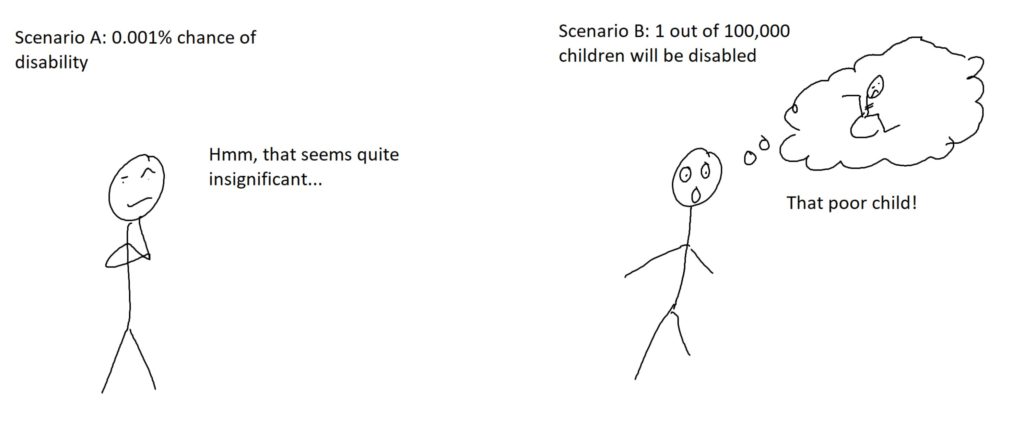
Copywriting Tips for Beginners [Imagery Hack]
What’s up, Copy Squad? Today I want to give you some cool copywriting tips for beginners.
I’m really excited to share this copywriting trick that I recently figured out.
I actually stumbled upon a scientific study that validates something that we’ve already been doing at Agora Financial…
So today we’re going to talk about a copywriting tip that I’m calling “The Imagery Hack.”
And the way “The Imagery Hack” works is by highlighting in your customer’s brain, the good things about your offer or product to make the positive aspects look more favorable and more real…
While making the bad things seem negligible or even nonexistent.
In fact, the “bad things” may not even appear on your audience’s radar!
Even if you tell your customer in plain English “this bad thing could happen…”
There’s a chance that the customer still won’t care.
And I have some examples for you today.
But before we begin, we must talk about The Big 4 Emotions.
Copywriting Trick – The Big 4 Emotions
The Big 4 Emotions are my “claim to fame.” Targeting The Big 4 is the ultimate copywriting trick and is found in all good copywriting.
They are:
- New
- Easy
- Safe
- Big
(I wrote an entire book called Take Their Money on this topic of the Big 4 Emotions, and how they’re so important to selling anything.
The Imagery Hack is a single copywriting trick that can take care of two of the Big 4 Emotions: Safe and Big.
Tip To Write Better Copy – Remember, People Cannot Process Data
Let’s start with one fundamental fact that you must know if you want to write better copy: People cannot process data.
Your brain just can’t do it.
For whatever reason, I can tell you fact after fact after fact, but it will never compel you to action.
Copywriters are tasked with presenting numbers and facts and figures in a way that compels people to act.
That’s what The Imagery Hack does.
It takes data like numbers, percentages, and things that don’t register as significant to our brains…
And it turns that data into something useful that compels action.

Let’s start with an example…
I have 63 YouTube videos up right now and 60 of the videos are 100 percent “liked.”
(I might be inviting some trouble from haters right now).
So that means if you watch all of 63 of my videos you can expect that 95 percent of the time you are going to learn something useful that is going to improve your copy and help you make more sales.
Learning new information that can help you write better copy is why people come back to my channel.
That’s why 60 of my 63 videos have 100% “thumbs up.”
In this example I am not saying “95%”…
Instead I’m creating 60 “instances” which allows your brain to form an image.
What is Imagery? A Copywriting “Instance”
Through the use of imagery, we can take a ratio or a statistic, that could be framed as a percentage, and give it an “instance.”
In a sense, we are bringing the information in your argument to life.
Framing the same data as a percentage would not have been as impactful…
But why?
Let’s take a look at an example of where we want to present something negative to our audience.
“There is a treatment for sick kids with a 0.001 percent chance for permanent disability… “
Does that chance for permanent disability seem very significant to you?
What if I told you:
“There is a treatment for sick kids that causes one in 100,000 kids to become permanently disabled.”
When I present the same data from the above scenario as one in 100,000, I’m giving it an example. I’m giving it an “instance.”
I’m giving you something tangible and I’ve created an image of a single permanently disabled child in your brain.
When I present the scenario as one out of 100,000…
You immediately focused your attention to that one out of 100,000 instance even though I told you I was going to do it!
That’s because the one “instance” is now tangible.
On the flip side, your brain cannot process and imagine a 0.001 percent chance of a kid becoming sick.
That’s imagery being used to sway emotion.
Here’s a clip of The Imagery Hack spotted inside a sales letter!
Creating Influence Through Denominator Neglect In Your Copy
When the scenario above is presented as one out of 100,000, instead of a percentage you create a fraction (1/100,000) with a “numerator” and a “denominator.”
And the phenomenon that occurred in the imagery hack is a scientific term called “Denominator Neglect.”
What you can you do with Denominator Neglect?

For one, understanding Denominator Neglect is useful when you need to make a “negative” statement, but don’t want that information to dissuade your audience.
So you can frame a negative scenario as a percentage…
Because the brain can’t wrap its head around the percentage.
Basically, it’s a trick to sweep bad information under the rug.
Let’s say for example your legal department needs you to state something negative to your audience.
Maybe you want to offer transparency or a damning admission…
In these cases, frame your data as a percentage.
Because the brain can’t wrap its head around raw data, it won’t even process the percentage.
If I want my vaccine to be adopted, it would make sense for me to admit the medicine has a 0.001 percent chance to permanently disable a patient…
But if I am FIGHTING against the new vaccine, I would use the numerator and denominator to create an “instance” in my audience’s brain.
“One out of 100,000 kids who participate in this treatment will be permanently disabled.”

That is Denominator Neglect in action, and it is a very powerful tool that can influence the way you audience reacts to your argument.
Because thanks to Denominator Neglect, your audience will focus on the “numerator.”
The “ONE”… out of 100,000
If there is NO numerator, there is nothing for the brain to clasp on to.
If you only give your audience the percentage, you are only giving raw data.
And remember…the brain doesn’t care about raw data.
By Creating a Numerator, Your Copy Can Trivialize Bad Things and Emphasize the Good Aspects of a Situation
The goal of the imagery hack is to create some sort of imagery. An “instance.”
That is why I tell you that out of 63 of my videos…
60 of them are going to cause you to whip out your notepad and take some notes.
My content is going to help you write better copy to compel people to action.
Remember the scientific term for this is called Denominator Neglect.
I call it the Imagery Hack.
Pay very close attention when you are presenting facts and figures.
And make the information you have work for you.
Frame your data so that it forces your audience to draw up an image in their brain.
Using the Imagery Hack To Get More Sales (An Example)
Last year, Agora Financial put this principle into practice and we learned that it helped us to do better.
We knew that it was working for us…
And now I can tell you WHY.

Agora Financial used to frame all of our gain claims as percentages.
For example, would tell people “You can get 1,000% gain on this investment.”
Because a thousand percent gain sounds massive.
But even so, it wasn’t nearly as effective as when we told people they could make $10,000 from $1,000.
This is because people can’t imagine what they would do with a one thousand percent gain.
1,000% does not mean anything, practically, to our brain. A percentage is not tangible.
But people can imagine what they would do with $10,000.
By framing the same scenario in a different way, you can create an image that becomes clear whenever you have a something more tangible than a percentage.
To the brain, a percentage isn’t real.
And if it isn’t real, it doesn’t trigger imagery.
A percentage doesn’t tickle the imagination.
It can’t. It is just raw data.
So do not use percentages UNLESS you’re trying to minimize something bad.
Or only use a percentage so that you can immediately re-frame it.
Copywriting Hack – Reframing Your Claim
What do I mean by re-framing?
For example, you can tell your customers that a certain opportunity provides a 1,000% gain.
THEN say, “That means if you put in just $1,000, you could make $10,000.”
The second line is a re-frame of the percentage into something with imagery.
And it’s still just as powerful.
The more frames you can put on your claims, the more three-dimensional you can make your claim in the audience’s mind.
At Agora Financial, we changed from using percentages to using dollars, thus creating imagery.
We tell our customers “If you put in a thousand dollars you make ten thousand dollars.”
In this case, the result of the action (the numerator) is that you get $10,000
That means the denominator in this case is a $1,000.
What we found is that you can completely remove the denominator from your copy and folks will still buy!
In fact, you can just say “You will make $10,000” and never mention what the investment might be.
The denominator doesn’t matter. They will most likely neglect it anyway.
The brain does not care about the investment in this scenario…
Because the brain is imagining what will happen with $10,000.
I know if I want someone to really get hyped up about a scenario I am presenting…
I need to frame the raw data into something that causes their brain to begin drumming up imagery.
Anything you’re selling…
Frame it in terms of instances.

If you have something bad to talk about…
Something you don’t want to highlight…
Some fact you want to “diminish…”
Then frame the “negative” copy in terms of percentages and it is more likely to be overlooked.
And remember, we are mainly triggering 2 of the 4 Big 4 Emotions with this: Safe and Big.
My whole copywriting book Take Their Money goes into crazy depth explaining how you can use the Big 4 Emotions to make yourself a lot of money.
The Imagery Hack was an exciting thing for me to learn.
I realized why writing in dollars, instead of percentages, for Agora Financial promos has been so effective…
Because it’s creating imagery.
You want your copy to compel your audience to think about what they could experience or what could happen.
Okay, let’s talk about that. What if I told you…
“Mental patients who are off of their medications have 0.001 percent chance of harming other people.”
Or I said…
“One out of 100,000 murders are committed by mental patients who are off their medications.”
The first scenario seems so insignificant.
But if I frame it as one out of 100,000…
You completely neglect the fact that 100,000 is a massive number.
You completely neglect the Denominator and focus on the “one.”
Terrorism and the Imagery Hack
Terrorism works through the same process of creating imagery.
A scenario could be presented as one terrorist attack per zillion years, or one attack per a billion years, or one attack per thousands of square miles…
But as long as I hear the scenario as ONE attack per 500,000 square miles…
My brain does not care about the 500,000 square miles.
My brain does not process just how massive that denominator is.
My brain is focused on the “one,” focused on the numerator.
The terrorist threat is tangible when presented this way.
This is Denominator Neglect in action.
If you WANT to highlight negatives in a scenario, create an image for your audience.
Give your audience something tangible. A numerator.
Give them an “instance.”
The Media Also Uses Denominator Neglect, Like Copywriters
If the media presents a story as “one out of 100,000…” you will completely neglect the 100,000.
Your brain is focused on the “one” and has given no thought to the 100,000.
Likewise, when the media aims to play a threat down, they would cite related data as percentages.
The media would say “Terrorism has a 0.001 percent chance of happening in your area.”
This threat does not seem very significant.
In fact, the same threat does not even seem plausible when presented this way.
Your brain is not processing the percentage, no matter the significance.
But if you hear that there is a one in 100,000 chance that a bus will blow up in your neighborhood…
The media has created an image for your brain.
The threat is now real to you.
That is the Imagery Hack.
Let Me Help You Write Better Copy
As I was saying at the beginning, out of all 63 of my videos, 60 of them are all thumbs up.
That means if you watch my videos, 60 of those videos are going to make you whip out your notepad, and start scribbling down notes…
Because you’re excited about making more money and writing better copy.
That’s the benefit that I offer you.
My copywriting tips are why you should subscribe to my YouTube Channel.
My copywriting tricks are going to help you write better copy.
You are going to make more money.
You’re going to be headed towards that remote lifestyle…
Living wherever and doing whatever you want.
60 out of 63 times you sit down to watch one of my videos, you are going to get some awesome value.
And if you want to learn how to write words that really make you rich, check out my book: Take Their Money.
